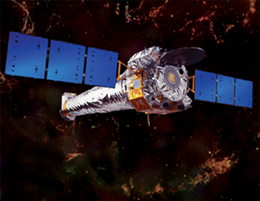August 23, 2005
MSFC NEWS RELEASE: 05-143

Illustration: CXC/NGST
In August 1999, NASA's Chandra X-ray Observatory opened for business. Six years later, it continues to achieve scientific firsts.
"When Chandra opened its sunshade doors for the first time, it opened the possibility of studying the X-ray emission of the universe with unprecedented clarity," said Chandra project scientist Dr. Martin Weisskopf of NASA's Marshall Space Flight Center in Huntsville, Ala. "Already surpassing its goal of a five-year life, Chandra continues to rewrite textbooks with discoveries about our own solar system and images of celestial objects as far as billions of light years away."
Based on the observatory's outstanding results, NASA Headquarters in Washington decided in 2001 to extend Chandra s mission from five years to ten. During the observatory s sixth year of operation, auroras from Jupiter, X-rays from Saturn, and the early days of our solar system were the focus of Chandra discoveries close to home -- discoveries with the potential to better understand the dynamics of life on Earth.
Jupiter's auroras are the most spectacular and active auroras in the solar system. Extended Chandra observations revealed that Jupiter s auroral X-rays are caused by highly charged particles crashing into the atmosphere above Jupiter's poles. These results gave scientists information needed to compare Jupiter's auroras with those from Earth, and determine if they are triggered by different cosmic and planetary events.
Mysterious X-rays from Saturn also received attention, as Chandra completed the first observation of a solar X-ray flare reflected from Saturn's low-latitudes, the region that correlates to Earth's equator and tropics. This observation led scientists to conclude the ringed planet may act as a mirror, reflecting explosive activity from the sun. Solar-storm watchers on Earth might see a surprising benefit. The results imply scientists could use giant planets like Saturn as remote-sensing tools to help monitor X-ray flaring on portions of the sun facing away from Earth's space satellites.
Another Chandra discovery -- gleaned from the deepest X-ray observation of any star cluster -- offered insights on Earth's survival in its infancy. Chandra s focus was the Orion Nebula, which contains at least 1,400 young stars, 30 that are prototypes of the early sun. Using Chandra, scientists learned these young stars produce violent X-ray flares much more frequently and energetically than anything seen today from our 4.6 billion-year-old sun. This implies super-flares torched our young solar system and likely affected the planet-forming disk around the early sun -- enhancing the survival chances of Earth.
Space is a harsh environment with extreme temperatures, harmful radiation and none of the protection offered by Earth s atmosphere, said Chandra Program Manager Keith Hefner of the Marshall Center. "Ironically, the fact that our atmosphere absorbs harmful X-rays is the very reason for Chandra s existence. Getting outside the absorbing atmosphere of the Earth requires space-based observatories, and viewing the universe in multiple wavelengths is necessary to fully study cosmic events. Chandra s continued outstanding performance after six years of operation under such harsh conditions is evidence that it is, indeed, an engineering marvel."
In its sixth year, Chandra also continued to build on its growing list of discoveries involving black holes. This included finding the most powerful eruption seen in the universe, generated by a supermassive black hole growing at a remarkable rate. The eruption -- which has lasted for 100 million years and is still going -- has generated the energy equivalent to hundreds of millions of gamma-ray bursts. This discovery illustrated the enormous appetite of large black holes, and the profound impact they have on their surroundings.
Other recent discoveries include confirming the existence of weight limits for supermassive black holes, finding evidence for a swarm of black holes near the galactic center and gathering more data supporting the existence of mid-sized black holes.
Marshall manages the Chandra program for NASA's Science Mission Directorate in Washington. Northrop Grumman of Redondo Beach, Calif., was the prime development contractor for the observatory. The Smithsonian Astrophysical Observatory controls science and flight operations from the Chandra X-ray Center in Cambridge, Mass.
Additional information and images are available at:
MEDIA CONTACTS
Steve Roy
Marshall Space Flight Center, Huntsville, Ala.
(Phone: 256/544-6535)


